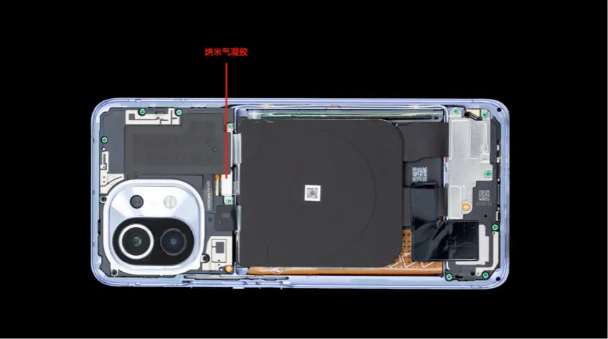 【 微信扫码咨询 】
【 微信扫码咨询 】
The essence of mobile phone heat dissipation is to quickly spread the local heat in the mobile phone through high thermal conductivity materials such as graphite, thermal gel, liquid-cooled copper tube/VC soaking plate, and spread it evenly across the mobile phone, and then conduct it to the outside world. However, as a heavy-duty handheld device, mobile phones have become increasingly powerful today. How to balance high thermal conductivity and mild and non-hot surface feel has become a compulsory course for every mobile phone research and development.
Mi 11 uses the current top-level mobile phone heat dissipation material, not only has a large area of liquid-cooled VC soaking plate, but also covers a large amount of graphite, copper foil, thermal gel, etc. to form a three-dimensional heat dissipation system. . However, this time Xiaomi 11 is not only satisfied with these heat-dissipating materials, but has gone a step further in optimizing the heat-dissipating path, using a brand-new thermal insulation material-nano aerogel. Through the combination of "one block and one block", the heat transfer during the heat dissipation process is more reasonable, and the heat dissipation is efficient while the hand feels gentle and not hot.

反弹琵琶有奇效!为什么需要一疏一堵?
Consumers generally believe that as long as a simple heat conduction is good enough for mobile phone heat dissipation. In fact, the calorific value of the mobile phone is relatively constant and relatively unadjustable, but the path of heat transfer can be optimized through thermal design. Inside the mobile phone, the Z-axis space is the shortest, the X-axis space is longer, and the Y-axis space is the most abundant. On thin and light mobile phones, the Z-axis space is even more cramped.
If the heat transfer is only accelerated without the brain, local heat is quickly transferred to the surface of the phone along the Z axis, which will only make the phone hotter to the touch, causing the illusion of serious heat generation. Reduce or even cut off the thermal conductivity of the Z-axis space, so that local components heat more to the X-axis and Y-axis directions, which can achieve rapid heat dissipation while taking into account the touch.

Xiaomi Mi 11 tried a new thermal insulation material nano aerogel, which cut off the conduction channel of mobile phone heating along the Z axis and blocked the transmission path between the internal heat source and the surface of the mobile phone. This part of the heat blocked passes through the internal heat of Xiaomi 11. The top three-dimensional heat dissipation system conducts in the X-axis and Y-axis, which not only solves the problem of local heating to ensure the normal operation of the chip, but also avoids local single-point heating that is prematurely perceived by the palm of the hand before it can be evenly heated.
Inspiration from down jacket! How does nano aerogel insulate heat?
How to keep warm in the cold winter, most people think of down jackets the first time. The inner structure of the down jacket is fluffy and retains a lot of air gaps. Because of the low thermal conductivity of air, the thick air layer maintains the temperature of the human body surface in the cold winter.
The nano aerogel used by Xiaomi Mi 11 is similar to the thermal insulation principle of down jackets. The inside of the nano aerogel is an organic molecular skeleton based on silica, which can wrap air in the cavity of the skeleton, and the air content is as high as 97%. Above, it's like a miniature down jacket. The air layer has extremely low thermal conductivity and can provide good thermal insulation. Moreover, the thin and light structure also allows the nano aerogel to have excellent heat insulation performance, while also meeting the needs of thin and light mobile phones.
This material has also been widely used in spacecraft and space stations. In order to cope with the huge temperature difference in space and maintain the temperature in the space capsule, this kind of high-performance and lightweight insulation material has become the best choice.

The development and trial of nano aerogels has not been smooth. From the initial concept to the demonstration and testing, Xiaomi's engineers continued to explore, test, fail, improve, and retest, and finally successfully broke through the technical difficulties. The top-level three-dimensional heat dissipation system of Xiaomi Mi 11 and the unique heat dissipation solution of nano aerogel "one sparse and one block" can allow users to use it with peace of mind, whether it is games or videos, without worrying about heat.